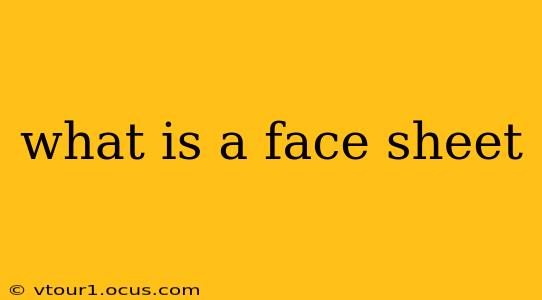A face sheet, also sometimes called a "patient face sheet" or simply a "face sheet," is a concise, readily accessible summary of a patient's key demographic and medical information. It acts as a quick reference guide for healthcare professionals, providing essential details at a glance. Think of it as the crucial first impression a healthcare provider gets of a patient's medical history, allergies, and current situation.
This document isn't meant to replace a full medical chart; rather, it complements it, offering immediate access to critical data during emergencies or when time is of the essence. Its brevity makes it ideal for quick assessments and efficient care coordination.
What Information is Typically Included on a Face Sheet?
The specifics can vary slightly depending on the healthcare setting (hospital, clinic, etc.) and the specific software used, but common elements include:
- Patient Identification: Full name, date of birth, gender, address, and contact information (phone number, email). This section ensures accurate patient identification and prevents mix-ups.
- Medical Record Number (MRN): A unique identifier assigned to each patient within the healthcare system.
- Date of Admission/Visit: The date the patient was admitted to the hospital or attended the clinic.
- Allergies: A list of known allergies, including medications, food, and environmental substances. This is crucial for preventing adverse reactions and ensuring patient safety. It's typically highlighted or presented in a bold font for easy visibility.
- Primary Physician: The patient's regular doctor who oversees their long-term care.
- Current Medications: A list of medications the patient is currently taking, including dosage and frequency. This helps healthcare providers avoid medication interactions and ensure proper medication management.
- Diagnoses: A summary of the patient's primary diagnoses or the reason for their current visit. This might be the primary diagnosis of the current hospital stay or visit, not necessarily their entire medical history.
- Emergency Contact: Information about a person to be contacted in case of emergency. This provides a rapid way to notify family or loved ones about a patient's condition.
- Insurance Information: Details about the patient's health insurance coverage, which is essential for billing and financial processes.
Why Are Face Sheets Important?
The importance of face sheets in healthcare lies in their ability to streamline access to critical patient information. Here are key benefits:
- Improved Efficiency: Quickly accessing crucial details saves valuable time in emergency situations or during busy periods.
- Enhanced Patient Safety: Prominent display of allergies prevents adverse reactions and improves safety protocols.
- Better Coordination of Care: Provides a consistent overview of the patient's condition for all healthcare providers involved.
- Reduced Medical Errors: Centralized information reduces the risk of overlooking critical details.
- Streamlined Billing: Easy access to insurance information facilitates efficient billing processes.
What is the Difference Between a Face Sheet and a Medical Chart?
While both contain patient information, they serve different purposes:
- Face Sheet: A concise summary of essential demographic and medical information. It's primarily for quick reference.
- Medical Chart: A comprehensive record of a patient's complete medical history, including detailed notes from appointments, test results, procedures, and other relevant information. It's the repository of the complete medical history.
How is a Face Sheet Used in Different Healthcare Settings?
Face sheets are used across various healthcare settings, including:
- Hospitals: During admissions, emergency room visits, and throughout a patient's hospital stay.
- Clinics: During routine check-ups, specialist visits, and other outpatient appointments.
- Nursing Homes: To track resident information and aid in quick assessments.
- Emergency Medical Services (EMS): To give first responders immediate access to vital information.
Are there any digital alternatives to paper face sheets?
Yes, many healthcare facilities now use electronic health records (EHRs) which contain digital versions of face sheets, often integrated with other patient information. These systems offer even greater efficiency and accessibility to information compared to paper-based systems.
In conclusion, the face sheet, despite its simple name, is a vital tool in modern healthcare. Its concise nature and easily accessible format make it indispensable for efficient and safe patient care.
